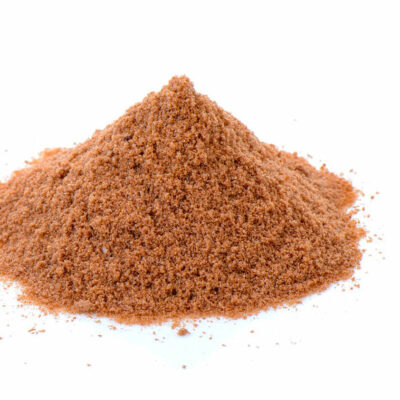Origin
Malt has been used since prehistoric times in brewing and bakery applications. Diastatic malt is considered the European bakers’ secret and is regarded as the normal source of alpha-amylase. In Germany, this malt is commonly used in the manufacture of small crusty rolls. 1
Function
Several functions can be attributed to diastatic malt in baked goods, namely: 1,2
- Sweetener: provides sweetness to baked goods.
- Color: imparts a characteristic brownish color and a subtract for Maillard reaction.
- Flavor: provides a distinctive flavor to baked goods.
- Nutritive: contains vitamins and essential amino acids.
- Shelf life extender: by trapping free water, it reduces its availability for microbial growth.
- Fermentation aid: provides food for yeast and aids in the strengthening of the gluten network.
- Improves loaf volume and texture.
Nutrition
Typical nutritional value of diastatic malt syrup per 100 g:3
| Component | Grams |
|---|---|
| Carbohydrate | 71.4 |
| Water | 21.1 |
| Protein | 6.2 |
| Ash | 1.3 |
The malt syrup provides 361 kcal per 100 g. It also provides vitamins and essential amino acids essential for several body functions. It has a low glycemic index in comparison to sucrose.3
Commercial production
The following processes are typically used in producing diastatic malt flour and syrup: 1,2
Flour:
- Steeping: barley kernels are mixed with water to raise hydration levels and increase metabolic activity.
- Germination: barley kernels are left to germinate for several days at controlled humidity and temperature conditions.
- Removal of sprout’s rootlets
- Drying: malted grains are dried at low temperatures to maintain enzymes activity.
- Milling: dried malted grains are milled to appropriate particle size similar to wheat flour.
Syrup:
- Crushed malted grain is mixed with water resulting in dissolution of maltose and
- Diastatic syrup is obtained from the concentration of the resulting liquid of the previous step.
Application
Diastatic malt syrup is used in the manufacture of baked products that require another source of food for yeast for the later stages of fermentation. General guidelines when working with this kind of malt’s syrup or flours: 1,2
- Short fermentation: it is ideal for short fermentation times by providing an ideal source of food for yeast.
- Long fermentation: high amount of starch degradation into maltose may cause sticky dough and crumb.
- When substituting malt syrup by dry malt, use the same weight of malt syrup and adjust the liquid content.
- Can be used to compensate for reduced enzyme activity in low amylase flours.
Usage level of diastatic malt syrup in common baked goods:2
| Baked goods | Usage level |
|---|---|
| Hard rolls | 1.25 % |
| Wheat rolls | 2.7 % |
| Sour Cream rolls | 0.5 % |
| Tomato bread | 0.5 % |
| Soda crackers | 0 – 0.1 % |
| Light rye bread | 0.5 % |
| Pumpernickel | 1.6 % |
| White pan bread | 0.5 – 1.5 % (baker’s percentage) |
| Sweet goods | 1.5 – 3.0 % (baker’s percentage) |
| French/Italian bread | 0.5 – 2.0% (baker’s percentage) |
| Whole wheat bread | 5.0 – 9.0% (baker’s percentage) |
| Pretzels | 1.5 – 6.0% (baker’s percentage) |
Regulations
Diastatic malt syrup is permitted for direct addition to food products by the FDA. The flour or barley malted flour can be used in wheat flour to compensate for enzyme deficiencies up to a maximum of 0.75%.4
In the EU, non roasted diastatic active malt is regulated by the EU Commission and it is considered safe for consumption.5
References
- BC Cook Articulation Committee. “Understanding Ingredients for the Canadian Baker”. 2018.
- NIIR Board of Consultants & Engineers.The Complete Technology Book On Bakery Products. 3rd ed., NPCS, 2014.
- U.S. Department of Agriculture, Agricultural Research Service. FoodData Central, 01 April 2019. https://fdc.nal.usda.gov/fdc-app.html#/food-details/169660/nutrients . Accessed 29 October 2020.
- U.S. Department of Health and Human Services.” Direct Food Substances Affirmed As Generally Recognized As Safe, Part. 184. April 2019. Available at https://www.accessdata.fda.gov/scripts/cdrh/cfdocs/cfcfr/CFRSearch.cfm?fr=184.1445 . Accessed 29 October 2020.
- European Commission (EC). EXPLANATORY NOTES TO THE COMBINED NOMENCLATURE OF THE EUROPEAN UNION (2015/C 076/01)Publication made in accordance with Article 9(1) of Council Regulation (EEC) No 2658/87 of 23 July 1987 on the tariff and statistical nomenclature and on the Common Customs Tariff . Official Journal of European Communities, 15 December 2008.

